Report on Teaching Principles, Learning, Communication, and Assessment
VerifiedAdded on 2023/06/08
|13
|4796
|238
Report
AI Summary
This report delves into the core principles of effective teaching within the context of business management. It analyzes various learning theories, including behaviorism, cognitive constructivism, and social constructivism, and explores different learning styles such as activists, theorists, pragmatists, and reflectors. The report examines how these theories can be applied to teaching, learning, and assessment, emphasizing the importance of understanding and accommodating individual learning preferences, such as those outlined in the VARK model (Visual, Auditory, Read/Write, Kinesthetic). Furthermore, the report explores communication theories and models, including the principles of clarity, informality, comprehensiveness, timeliness, and feedback, and how they can be utilized to enhance student engagement and understanding. Finally, the report discusses assessment models, highlighting the importance of student participation and self-realization in the learning process. The report aims to provide a comprehensive overview of effective teaching strategies and assessment methods in business management, with the goal of improving student outcomes. Desklib provides past papers and solved assignments to help students.
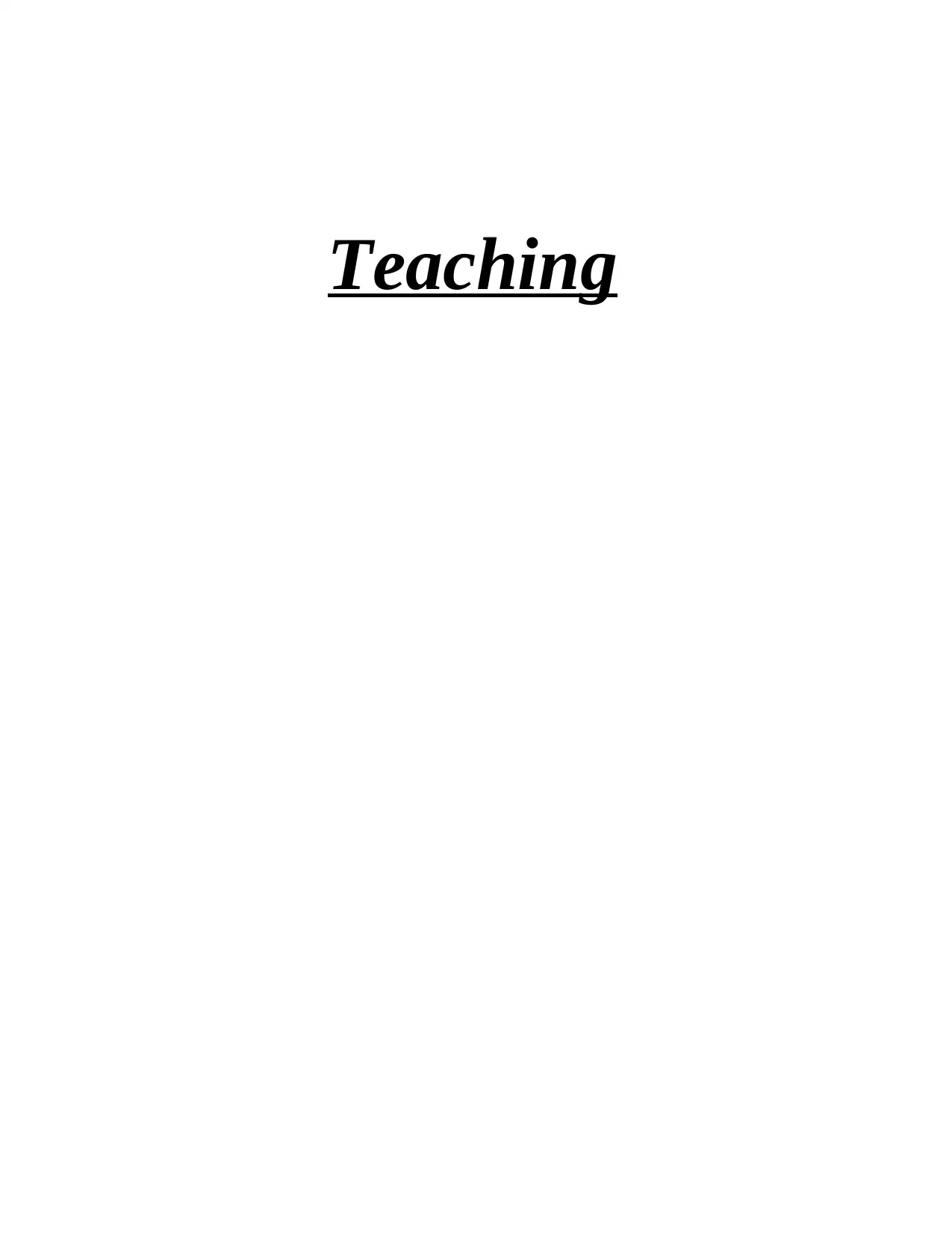
Teaching
Paraphrase This Document
Need a fresh take? Get an instant paraphrase of this document with our AI Paraphraser
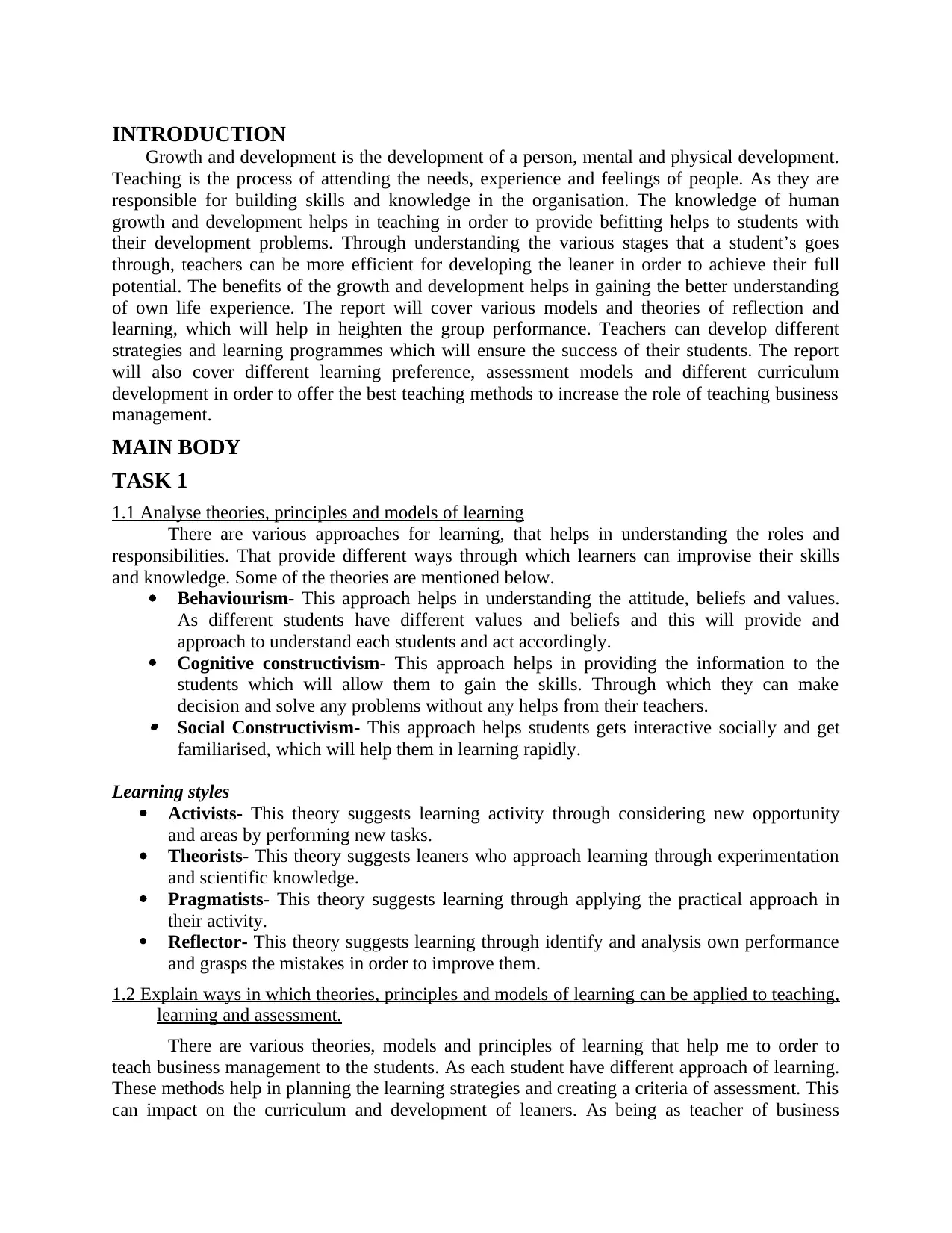
INTRODUCTION
Growth and development is the development of a person, mental and physical development.
Teaching is the process of attending the needs, experience and feelings of people. As they are
responsible for building skills and knowledge in the organisation. The knowledge of human
growth and development helps in teaching in order to provide befitting helps to students with
their development problems. Through understanding the various stages that a student’s goes
through, teachers can be more efficient for developing the leaner in order to achieve their full
potential. The benefits of the growth and development helps in gaining the better understanding
of own life experience. The report will cover various models and theories of reflection and
learning, which will help in heighten the group performance. Teachers can develop different
strategies and learning programmes which will ensure the success of their students. The report
will also cover different learning preference, assessment models and different curriculum
development in order to offer the best teaching methods to increase the role of teaching business
management.
MAIN BODY
TASK 1
1.1 Analyse theories, principles and models of learning
There are various approaches for learning, that helps in understanding the roles and
responsibilities. That provide different ways through which learners can improvise their skills
and knowledge. Some of the theories are mentioned below.
Behaviourism- This approach helps in understanding the attitude, beliefs and values.
As different students have different values and beliefs and this will provide and
approach to understand each students and act accordingly.
Cognitive constructivism- This approach helps in providing the information to the
students which will allow them to gain the skills. Through which they can make
decision and solve any problems without any helps from their teachers.
Social Constructivism- This approach helps students gets interactive socially and get
familiarised, which will help them in learning rapidly.
Learning styles
Activists- This theory suggests learning activity through considering new opportunity
and areas by performing new tasks.
Theorists- This theory suggests leaners who approach learning through experimentation
and scientific knowledge.
Pragmatists- This theory suggests learning through applying the practical approach in
their activity.
Reflector- This theory suggests learning through identify and analysis own performance
and grasps the mistakes in order to improve them.
1.2 Explain ways in which theories, principles and models of learning can be applied to teaching,
learning and assessment.
There are various theories, models and principles of learning that help me to order to
teach business management to the students. As each student have different approach of learning.
These methods help in planning the learning strategies and creating a criteria of assessment. This
can impact on the curriculum and development of leaners. As being as teacher of business
Growth and development is the development of a person, mental and physical development.
Teaching is the process of attending the needs, experience and feelings of people. As they are
responsible for building skills and knowledge in the organisation. The knowledge of human
growth and development helps in teaching in order to provide befitting helps to students with
their development problems. Through understanding the various stages that a student’s goes
through, teachers can be more efficient for developing the leaner in order to achieve their full
potential. The benefits of the growth and development helps in gaining the better understanding
of own life experience. The report will cover various models and theories of reflection and
learning, which will help in heighten the group performance. Teachers can develop different
strategies and learning programmes which will ensure the success of their students. The report
will also cover different learning preference, assessment models and different curriculum
development in order to offer the best teaching methods to increase the role of teaching business
management.
MAIN BODY
TASK 1
1.1 Analyse theories, principles and models of learning
There are various approaches for learning, that helps in understanding the roles and
responsibilities. That provide different ways through which learners can improvise their skills
and knowledge. Some of the theories are mentioned below.
Behaviourism- This approach helps in understanding the attitude, beliefs and values.
As different students have different values and beliefs and this will provide and
approach to understand each students and act accordingly.
Cognitive constructivism- This approach helps in providing the information to the
students which will allow them to gain the skills. Through which they can make
decision and solve any problems without any helps from their teachers.
Social Constructivism- This approach helps students gets interactive socially and get
familiarised, which will help them in learning rapidly.
Learning styles
Activists- This theory suggests learning activity through considering new opportunity
and areas by performing new tasks.
Theorists- This theory suggests leaners who approach learning through experimentation
and scientific knowledge.
Pragmatists- This theory suggests learning through applying the practical approach in
their activity.
Reflector- This theory suggests learning through identify and analysis own performance
and grasps the mistakes in order to improve them.
1.2 Explain ways in which theories, principles and models of learning can be applied to teaching,
learning and assessment.
There are various theories, models and principles of learning that help me to order to
teach business management to the students. As each student have different approach of learning.
These methods help in planning the learning strategies and creating a criteria of assessment. This
can impact on the curriculum and development of leaners. As being as teacher of business
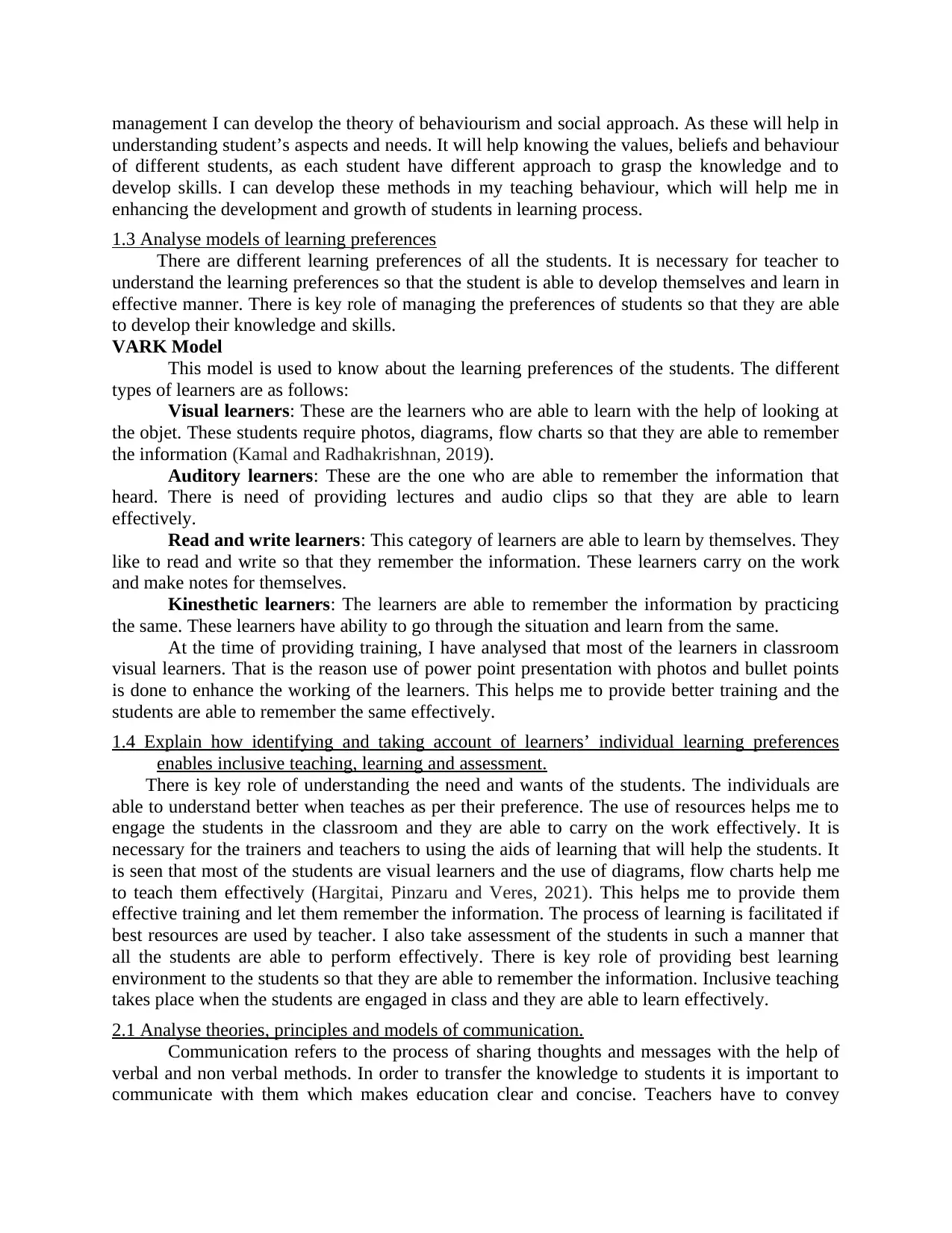
management I can develop the theory of behaviourism and social approach. As these will help in
understanding student’s aspects and needs. It will help knowing the values, beliefs and behaviour
of different students, as each student have different approach to grasp the knowledge and to
develop skills. I can develop these methods in my teaching behaviour, which will help me in
enhancing the development and growth of students in learning process.
1.3 Analyse models of learning preferences
There are different learning preferences of all the students. It is necessary for teacher to
understand the learning preferences so that the student is able to develop themselves and learn in
effective manner. There is key role of managing the preferences of students so that they are able
to develop their knowledge and skills.
VARK Model
This model is used to know about the learning preferences of the students. The different
types of learners are as follows:
Visual learners: These are the learners who are able to learn with the help of looking at
the objet. These students require photos, diagrams, flow charts so that they are able to remember
the information (Kamal and Radhakrishnan, 2019).
Auditory learners: These are the one who are able to remember the information that
heard. There is need of providing lectures and audio clips so that they are able to learn
effectively.
Read and write learners: This category of learners are able to learn by themselves. They
like to read and write so that they remember the information. These learners carry on the work
and make notes for themselves.
Kinesthetic learners: The learners are able to remember the information by practicing
the same. These learners have ability to go through the situation and learn from the same.
At the time of providing training, I have analysed that most of the learners in classroom
visual learners. That is the reason use of power point presentation with photos and bullet points
is done to enhance the working of the learners. This helps me to provide better training and the
students are able to remember the same effectively.
1.4 Explain how identifying and taking account of learners’ individual learning preferences
enables inclusive teaching, learning and assessment.
There is key role of understanding the need and wants of the students. The individuals are
able to understand better when teaches as per their preference. The use of resources helps me to
engage the students in the classroom and they are able to carry on the work effectively. It is
necessary for the trainers and teachers to using the aids of learning that will help the students. It
is seen that most of the students are visual learners and the use of diagrams, flow charts help me
to teach them effectively (Hargitai, Pinzaru and Veres, 2021). This helps me to provide them
effective training and let them remember the information. The process of learning is facilitated if
best resources are used by teacher. I also take assessment of the students in such a manner that
all the students are able to perform effectively. There is key role of providing best learning
environment to the students so that they are able to remember the information. Inclusive teaching
takes place when the students are engaged in class and they are able to learn effectively.
2.1 Analyse theories, principles and models of communication.
Communication refers to the process of sharing thoughts and messages with the help of
verbal and non verbal methods. In order to transfer the knowledge to students it is important to
communicate with them which makes education clear and concise. Teachers have to convey
understanding student’s aspects and needs. It will help knowing the values, beliefs and behaviour
of different students, as each student have different approach to grasp the knowledge and to
develop skills. I can develop these methods in my teaching behaviour, which will help me in
enhancing the development and growth of students in learning process.
1.3 Analyse models of learning preferences
There are different learning preferences of all the students. It is necessary for teacher to
understand the learning preferences so that the student is able to develop themselves and learn in
effective manner. There is key role of managing the preferences of students so that they are able
to develop their knowledge and skills.
VARK Model
This model is used to know about the learning preferences of the students. The different
types of learners are as follows:
Visual learners: These are the learners who are able to learn with the help of looking at
the objet. These students require photos, diagrams, flow charts so that they are able to remember
the information (Kamal and Radhakrishnan, 2019).
Auditory learners: These are the one who are able to remember the information that
heard. There is need of providing lectures and audio clips so that they are able to learn
effectively.
Read and write learners: This category of learners are able to learn by themselves. They
like to read and write so that they remember the information. These learners carry on the work
and make notes for themselves.
Kinesthetic learners: The learners are able to remember the information by practicing
the same. These learners have ability to go through the situation and learn from the same.
At the time of providing training, I have analysed that most of the learners in classroom
visual learners. That is the reason use of power point presentation with photos and bullet points
is done to enhance the working of the learners. This helps me to provide better training and the
students are able to remember the same effectively.
1.4 Explain how identifying and taking account of learners’ individual learning preferences
enables inclusive teaching, learning and assessment.
There is key role of understanding the need and wants of the students. The individuals are
able to understand better when teaches as per their preference. The use of resources helps me to
engage the students in the classroom and they are able to carry on the work effectively. It is
necessary for the trainers and teachers to using the aids of learning that will help the students. It
is seen that most of the students are visual learners and the use of diagrams, flow charts help me
to teach them effectively (Hargitai, Pinzaru and Veres, 2021). This helps me to provide them
effective training and let them remember the information. The process of learning is facilitated if
best resources are used by teacher. I also take assessment of the students in such a manner that
all the students are able to perform effectively. There is key role of providing best learning
environment to the students so that they are able to remember the information. Inclusive teaching
takes place when the students are engaged in class and they are able to learn effectively.
2.1 Analyse theories, principles and models of communication.
Communication refers to the process of sharing thoughts and messages with the help of
verbal and non verbal methods. In order to transfer the knowledge to students it is important to
communicate with them which makes education clear and concise. Teachers have to convey
⊘ This is a preview!⊘
Do you want full access?
Subscribe today to unlock all pages.

Trusted by 1+ million students worldwide
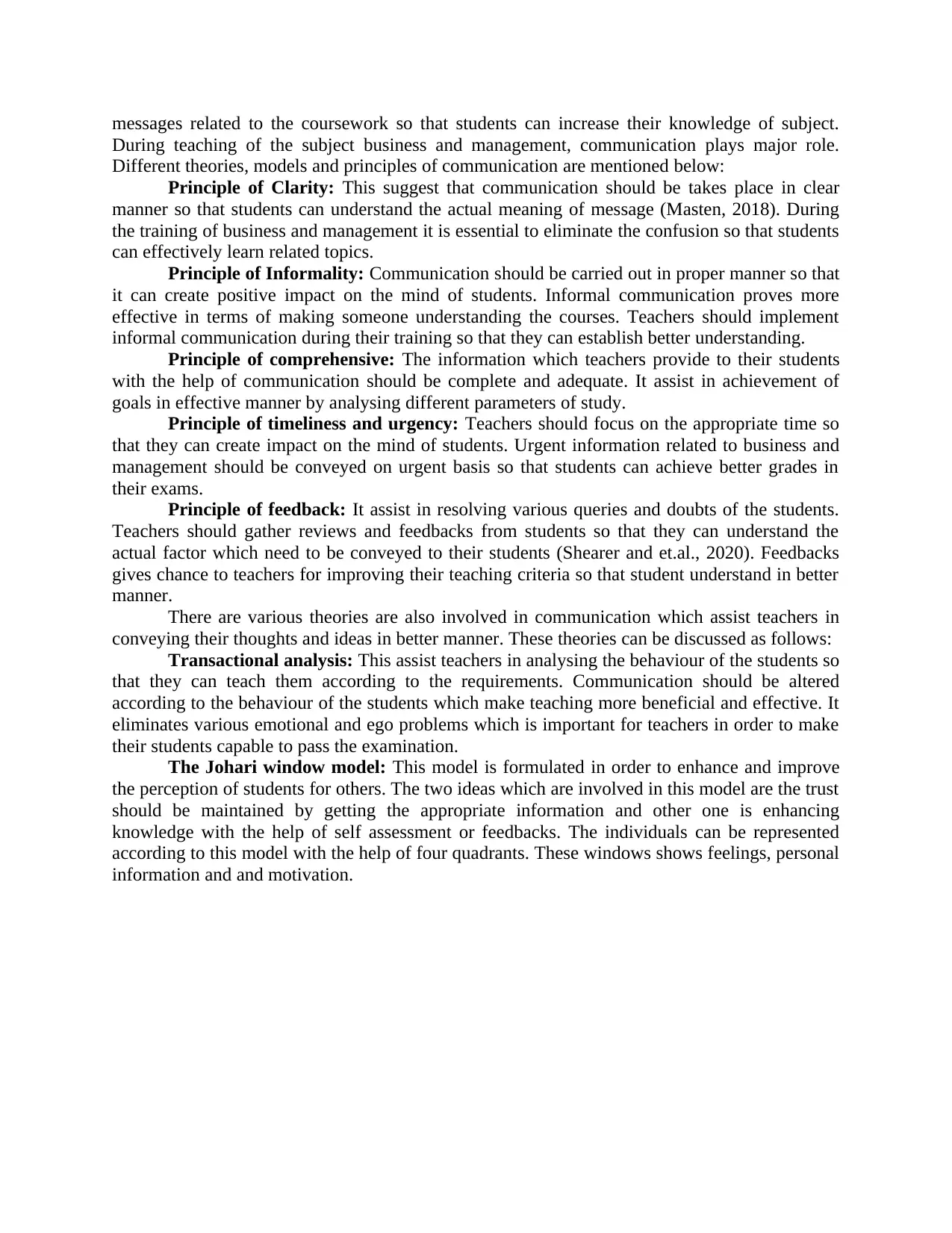
messages related to the coursework so that students can increase their knowledge of subject.
During teaching of the subject business and management, communication plays major role.
Different theories, models and principles of communication are mentioned below:
Principle of Clarity: This suggest that communication should be takes place in clear
manner so that students can understand the actual meaning of message (Masten, 2018). During
the training of business and management it is essential to eliminate the confusion so that students
can effectively learn related topics.
Principle of Informality: Communication should be carried out in proper manner so that
it can create positive impact on the mind of students. Informal communication proves more
effective in terms of making someone understanding the courses. Teachers should implement
informal communication during their training so that they can establish better understanding.
Principle of comprehensive: The information which teachers provide to their students
with the help of communication should be complete and adequate. It assist in achievement of
goals in effective manner by analysing different parameters of study.
Principle of timeliness and urgency: Teachers should focus on the appropriate time so
that they can create impact on the mind of students. Urgent information related to business and
management should be conveyed on urgent basis so that students can achieve better grades in
their exams.
Principle of feedback: It assist in resolving various queries and doubts of the students.
Teachers should gather reviews and feedbacks from students so that they can understand the
actual factor which need to be conveyed to their students (Shearer and et.al., 2020). Feedbacks
gives chance to teachers for improving their teaching criteria so that student understand in better
manner.
There are various theories are also involved in communication which assist teachers in
conveying their thoughts and ideas in better manner. These theories can be discussed as follows:
Transactional analysis: This assist teachers in analysing the behaviour of the students so
that they can teach them according to the requirements. Communication should be altered
according to the behaviour of the students which make teaching more beneficial and effective. It
eliminates various emotional and ego problems which is important for teachers in order to make
their students capable to pass the examination.
The Johari window model: This model is formulated in order to enhance and improve
the perception of students for others. The two ideas which are involved in this model are the trust
should be maintained by getting the appropriate information and other one is enhancing
knowledge with the help of self assessment or feedbacks. The individuals can be represented
according to this model with the help of four quadrants. These windows shows feelings, personal
information and and motivation.
During teaching of the subject business and management, communication plays major role.
Different theories, models and principles of communication are mentioned below:
Principle of Clarity: This suggest that communication should be takes place in clear
manner so that students can understand the actual meaning of message (Masten, 2018). During
the training of business and management it is essential to eliminate the confusion so that students
can effectively learn related topics.
Principle of Informality: Communication should be carried out in proper manner so that
it can create positive impact on the mind of students. Informal communication proves more
effective in terms of making someone understanding the courses. Teachers should implement
informal communication during their training so that they can establish better understanding.
Principle of comprehensive: The information which teachers provide to their students
with the help of communication should be complete and adequate. It assist in achievement of
goals in effective manner by analysing different parameters of study.
Principle of timeliness and urgency: Teachers should focus on the appropriate time so
that they can create impact on the mind of students. Urgent information related to business and
management should be conveyed on urgent basis so that students can achieve better grades in
their exams.
Principle of feedback: It assist in resolving various queries and doubts of the students.
Teachers should gather reviews and feedbacks from students so that they can understand the
actual factor which need to be conveyed to their students (Shearer and et.al., 2020). Feedbacks
gives chance to teachers for improving their teaching criteria so that student understand in better
manner.
There are various theories are also involved in communication which assist teachers in
conveying their thoughts and ideas in better manner. These theories can be discussed as follows:
Transactional analysis: This assist teachers in analysing the behaviour of the students so
that they can teach them according to the requirements. Communication should be altered
according to the behaviour of the students which make teaching more beneficial and effective. It
eliminates various emotional and ego problems which is important for teachers in order to make
their students capable to pass the examination.
The Johari window model: This model is formulated in order to enhance and improve
the perception of students for others. The two ideas which are involved in this model are the trust
should be maintained by getting the appropriate information and other one is enhancing
knowledge with the help of self assessment or feedbacks. The individuals can be represented
according to this model with the help of four quadrants. These windows shows feelings, personal
information and and motivation.
Paraphrase This Document
Need a fresh take? Get an instant paraphrase of this document with our AI Paraphraser
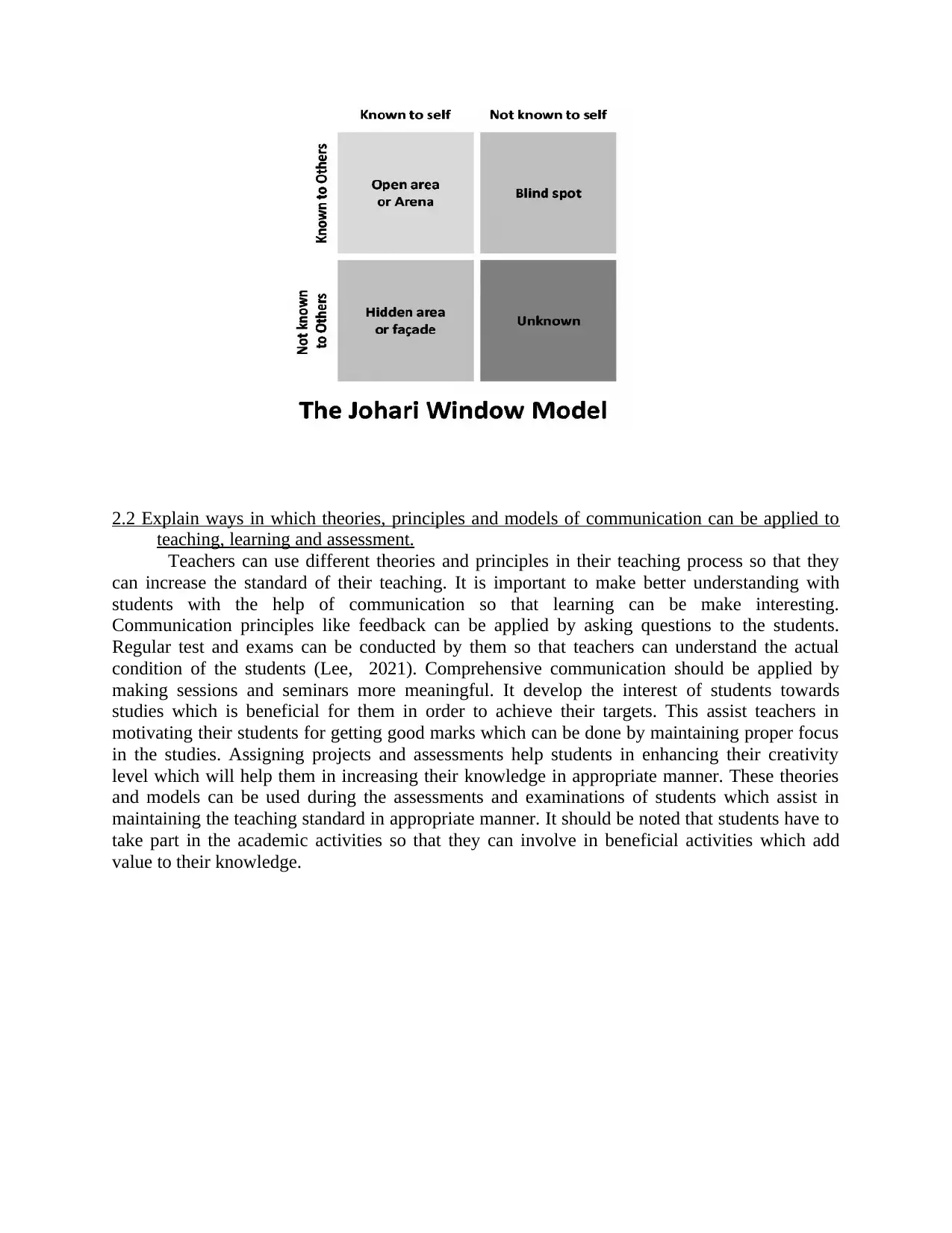
2.2 Explain ways in which theories, principles and models of communication can be applied to
teaching, learning and assessment.
Teachers can use different theories and principles in their teaching process so that they
can increase the standard of their teaching. It is important to make better understanding with
students with the help of communication so that learning can be make interesting.
Communication principles like feedback can be applied by asking questions to the students.
Regular test and exams can be conducted by them so that teachers can understand the actual
condition of the students (Lee, 2021). Comprehensive communication should be applied by
making sessions and seminars more meaningful. It develop the interest of students towards
studies which is beneficial for them in order to achieve their targets. This assist teachers in
motivating their students for getting good marks which can be done by maintaining proper focus
in the studies. Assigning projects and assessments help students in enhancing their creativity
level which will help them in increasing their knowledge in appropriate manner. These theories
and models can be used during the assessments and examinations of students which assist in
maintaining the teaching standard in appropriate manner. It should be noted that students have to
take part in the academic activities so that they can involve in beneficial activities which add
value to their knowledge.
teaching, learning and assessment.
Teachers can use different theories and principles in their teaching process so that they
can increase the standard of their teaching. It is important to make better understanding with
students with the help of communication so that learning can be make interesting.
Communication principles like feedback can be applied by asking questions to the students.
Regular test and exams can be conducted by them so that teachers can understand the actual
condition of the students (Lee, 2021). Comprehensive communication should be applied by
making sessions and seminars more meaningful. It develop the interest of students towards
studies which is beneficial for them in order to achieve their targets. This assist teachers in
motivating their students for getting good marks which can be done by maintaining proper focus
in the studies. Assigning projects and assessments help students in enhancing their creativity
level which will help them in increasing their knowledge in appropriate manner. These theories
and models can be used during the assessments and examinations of students which assist in
maintaining the teaching standard in appropriate manner. It should be noted that students have to
take part in the academic activities so that they can involve in beneficial activities which add
value to their knowledge.
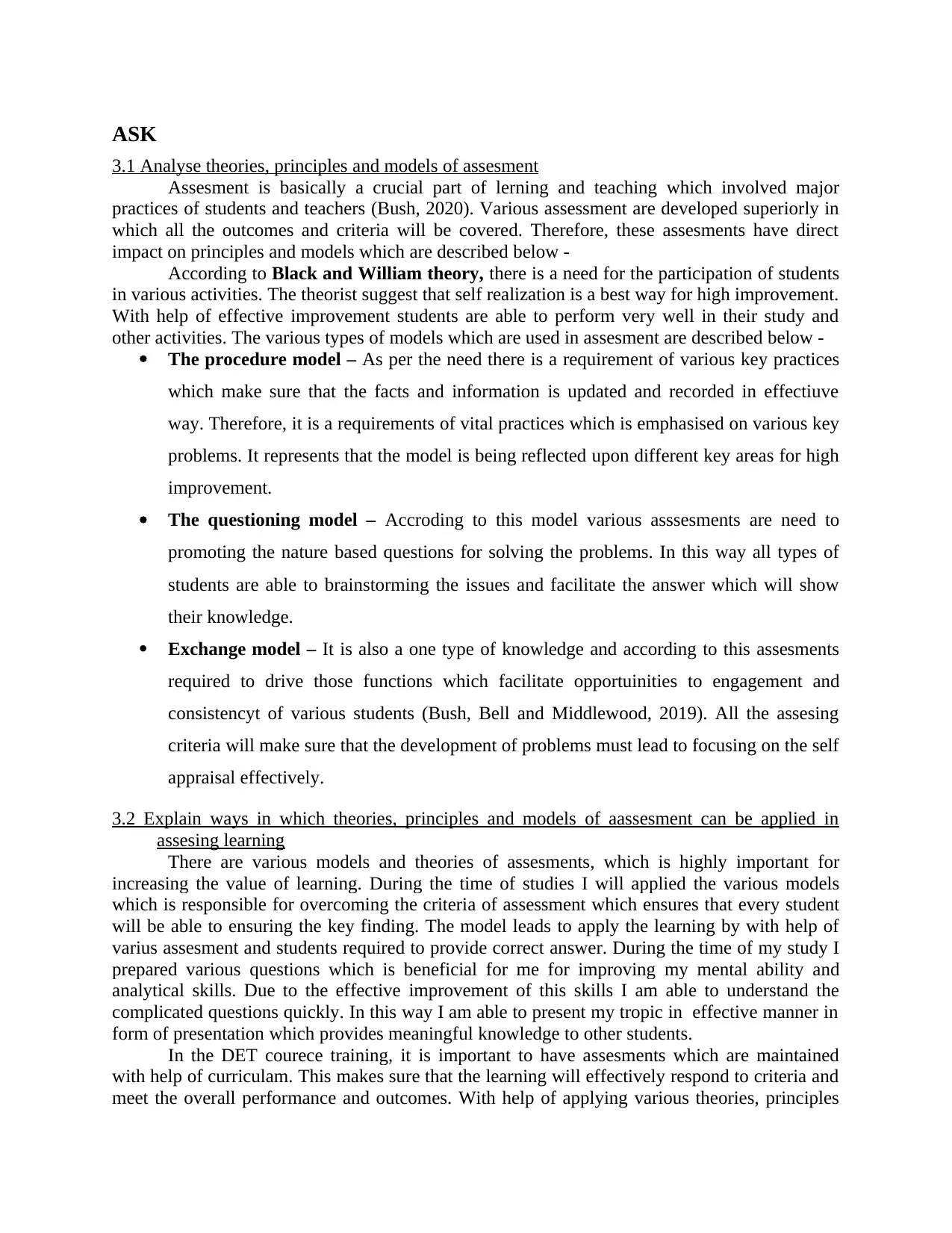
ASK
3.1 Analyse theories, principles and models of assesment
Assesment is basically a crucial part of lerning and teaching which involved major
practices of students and teachers (Bush, 2020). Various assessment are developed superiorly in
which all the outcomes and criteria will be covered. Therefore, these assesments have direct
impact on principles and models which are described below -
According to Black and William theory, there is a need for the participation of students
in various activities. The theorist suggest that self realization is a best way for high improvement.
With help of effective improvement students are able to perform very well in their study and
other activities. The various types of models which are used in assesment are described below -
The procedure model – As per the need there is a requirement of various key practices
which make sure that the facts and information is updated and recorded in effectiuve
way. Therefore, it is a requirements of vital practices which is emphasised on various key
problems. It represents that the model is being reflected upon different key areas for high
improvement.
The questioning model – Accroding to this model various asssesments are need to
promoting the nature based questions for solving the problems. In this way all types of
students are able to brainstorming the issues and facilitate the answer which will show
their knowledge.
Exchange model – It is also a one type of knowledge and according to this assesments
required to drive those functions which facilitate opportuinities to engagement and
consistencyt of various students (Bush, Bell and Middlewood, 2019). All the assesing
criteria will make sure that the development of problems must lead to focusing on the self
appraisal effectively.
3.2 Explain ways in which theories, principles and models of aassesment can be applied in
assesing learning
There are various models and theories of assesments, which is highly important for
increasing the value of learning. During the time of studies I will applied the various models
which is responsible for overcoming the criteria of assessment which ensures that every student
will be able to ensuring the key finding. The model leads to apply the learning by with help of
varius assesment and students required to provide correct answer. During the time of my study I
prepared various questions which is beneficial for me for improving my mental ability and
analytical skills. Due to the effective improvement of this skills I am able to understand the
complicated questions quickly. In this way I am able to present my tropic in effective manner in
form of presentation which provides meaningful knowledge to other students.
In the DET courece training, it is important to have assesments which are maintained
with help of curriculam. This makes sure that the learning will effectively respond to criteria and
meet the overall performance and outcomes. With help of applying various theories, principles
3.1 Analyse theories, principles and models of assesment
Assesment is basically a crucial part of lerning and teaching which involved major
practices of students and teachers (Bush, 2020). Various assessment are developed superiorly in
which all the outcomes and criteria will be covered. Therefore, these assesments have direct
impact on principles and models which are described below -
According to Black and William theory, there is a need for the participation of students
in various activities. The theorist suggest that self realization is a best way for high improvement.
With help of effective improvement students are able to perform very well in their study and
other activities. The various types of models which are used in assesment are described below -
The procedure model – As per the need there is a requirement of various key practices
which make sure that the facts and information is updated and recorded in effectiuve
way. Therefore, it is a requirements of vital practices which is emphasised on various key
problems. It represents that the model is being reflected upon different key areas for high
improvement.
The questioning model – Accroding to this model various asssesments are need to
promoting the nature based questions for solving the problems. In this way all types of
students are able to brainstorming the issues and facilitate the answer which will show
their knowledge.
Exchange model – It is also a one type of knowledge and according to this assesments
required to drive those functions which facilitate opportuinities to engagement and
consistencyt of various students (Bush, Bell and Middlewood, 2019). All the assesing
criteria will make sure that the development of problems must lead to focusing on the self
appraisal effectively.
3.2 Explain ways in which theories, principles and models of aassesment can be applied in
assesing learning
There are various models and theories of assesments, which is highly important for
increasing the value of learning. During the time of studies I will applied the various models
which is responsible for overcoming the criteria of assessment which ensures that every student
will be able to ensuring the key finding. The model leads to apply the learning by with help of
varius assesment and students required to provide correct answer. During the time of my study I
prepared various questions which is beneficial for me for improving my mental ability and
analytical skills. Due to the effective improvement of this skills I am able to understand the
complicated questions quickly. In this way I am able to present my tropic in effective manner in
form of presentation which provides meaningful knowledge to other students.
In the DET courece training, it is important to have assesments which are maintained
with help of curriculam. This makes sure that the learning will effectively respond to criteria and
meet the overall performance and outcomes. With help of applying various theories, principles
⊘ This is a preview!⊘
Do you want full access?
Subscribe today to unlock all pages.

Trusted by 1+ million students worldwide
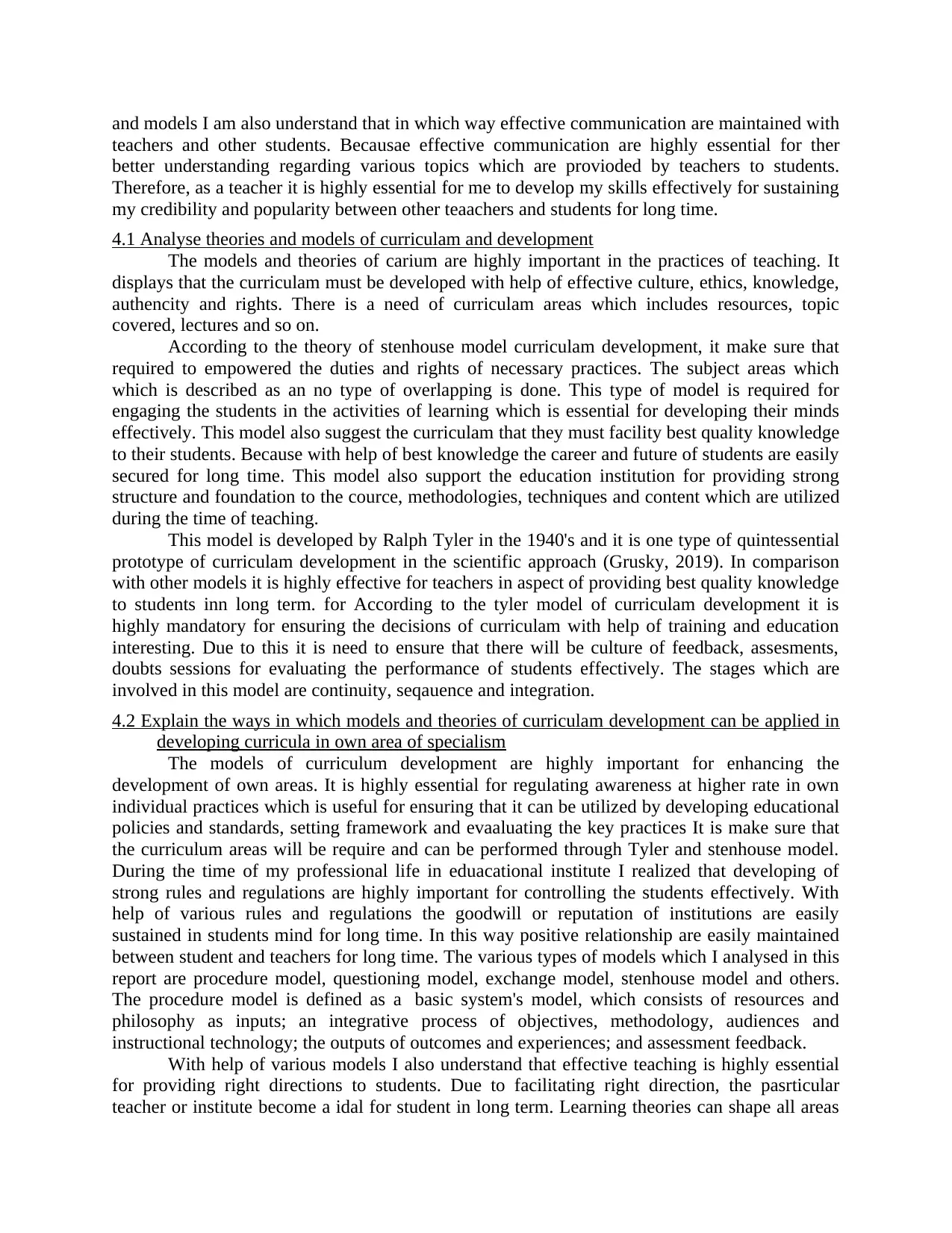
and models I am also understand that in which way effective communication are maintained with
teachers and other students. Becausae effective communication are highly essential for ther
better understanding regarding various topics which are provioded by teachers to students.
Therefore, as a teacher it is highly essential for me to develop my skills effectively for sustaining
my credibility and popularity between other teaachers and students for long time.
4.1 Analyse theories and models of curriculam and development
The models and theories of carium are highly important in the practices of teaching. It
displays that the curriculam must be developed with help of effective culture, ethics, knowledge,
authencity and rights. There is a need of curriculam areas which includes resources, topic
covered, lectures and so on.
According to the theory of stenhouse model curriculam development, it make sure that
required to empowered the duties and rights of necessary practices. The subject areas which
which is described as an no type of overlapping is done. This type of model is required for
engaging the students in the activities of learning which is essential for developing their minds
effectively. This model also suggest the curriculam that they must facility best quality knowledge
to their students. Because with help of best knowledge the career and future of students are easily
secured for long time. This model also support the education institution for providing strong
structure and foundation to the cource, methodologies, techniques and content which are utilized
during the time of teaching.
This model is developed by Ralph Tyler in the 1940's and it is one type of quintessential
prototype of curriculam development in the scientific approach (Grusky, 2019). In comparison
with other models it is highly effective for teachers in aspect of providing best quality knowledge
to students inn long term. for According to the tyler model of curriculam development it is
highly mandatory for ensuring the decisions of curriculam with help of training and education
interesting. Due to this it is need to ensure that there will be culture of feedback, assesments,
doubts sessions for evaluating the performance of students effectively. The stages which are
involved in this model are continuity, seqauence and integration.
4.2 Explain the ways in which models and theories of curriculam development can be applied in
developing curricula in own area of specialism
The models of curriculum development are highly important for enhancing the
development of own areas. It is highly essential for regulating awareness at higher rate in own
individual practices which is useful for ensuring that it can be utilized by developing educational
policies and standards, setting framework and evaaluating the key practices It is make sure that
the curriculum areas will be require and can be performed through Tyler and stenhouse model.
During the time of my professional life in eduacational institute I realized that developing of
strong rules and regulations are highly important for controlling the students effectively. With
help of various rules and regulations the goodwill or reputation of institutions are easily
sustained in students mind for long time. In this way positive relationship are easily maintained
between student and teachers for long time. The various types of models which I analysed in this
report are procedure model, questioning model, exchange model, stenhouse model and others.
The procedure model is defined as a basic system's model, which consists of resources and
philosophy as inputs; an integrative process of objectives, methodology, audiences and
instructional technology; the outputs of outcomes and experiences; and assessment feedback.
With help of various models I also understand that effective teaching is highly essential
for providing right directions to students. Due to facilitating right direction, the pasrticular
teacher or institute become a idal for student in long term. Learning theories can shape all areas
teachers and other students. Becausae effective communication are highly essential for ther
better understanding regarding various topics which are provioded by teachers to students.
Therefore, as a teacher it is highly essential for me to develop my skills effectively for sustaining
my credibility and popularity between other teaachers and students for long time.
4.1 Analyse theories and models of curriculam and development
The models and theories of carium are highly important in the practices of teaching. It
displays that the curriculam must be developed with help of effective culture, ethics, knowledge,
authencity and rights. There is a need of curriculam areas which includes resources, topic
covered, lectures and so on.
According to the theory of stenhouse model curriculam development, it make sure that
required to empowered the duties and rights of necessary practices. The subject areas which
which is described as an no type of overlapping is done. This type of model is required for
engaging the students in the activities of learning which is essential for developing their minds
effectively. This model also suggest the curriculam that they must facility best quality knowledge
to their students. Because with help of best knowledge the career and future of students are easily
secured for long time. This model also support the education institution for providing strong
structure and foundation to the cource, methodologies, techniques and content which are utilized
during the time of teaching.
This model is developed by Ralph Tyler in the 1940's and it is one type of quintessential
prototype of curriculam development in the scientific approach (Grusky, 2019). In comparison
with other models it is highly effective for teachers in aspect of providing best quality knowledge
to students inn long term. for According to the tyler model of curriculam development it is
highly mandatory for ensuring the decisions of curriculam with help of training and education
interesting. Due to this it is need to ensure that there will be culture of feedback, assesments,
doubts sessions for evaluating the performance of students effectively. The stages which are
involved in this model are continuity, seqauence and integration.
4.2 Explain the ways in which models and theories of curriculam development can be applied in
developing curricula in own area of specialism
The models of curriculum development are highly important for enhancing the
development of own areas. It is highly essential for regulating awareness at higher rate in own
individual practices which is useful for ensuring that it can be utilized by developing educational
policies and standards, setting framework and evaaluating the key practices It is make sure that
the curriculum areas will be require and can be performed through Tyler and stenhouse model.
During the time of my professional life in eduacational institute I realized that developing of
strong rules and regulations are highly important for controlling the students effectively. With
help of various rules and regulations the goodwill or reputation of institutions are easily
sustained in students mind for long time. In this way positive relationship are easily maintained
between student and teachers for long time. The various types of models which I analysed in this
report are procedure model, questioning model, exchange model, stenhouse model and others.
The procedure model is defined as a basic system's model, which consists of resources and
philosophy as inputs; an integrative process of objectives, methodology, audiences and
instructional technology; the outputs of outcomes and experiences; and assessment feedback.
With help of various models I also understand that effective teaching is highly essential
for providing right directions to students. Due to facilitating right direction, the pasrticular
teacher or institute become a idal for student in long term. Learning theories can shape all areas
Paraphrase This Document
Need a fresh take? Get an instant paraphrase of this document with our AI Paraphraser
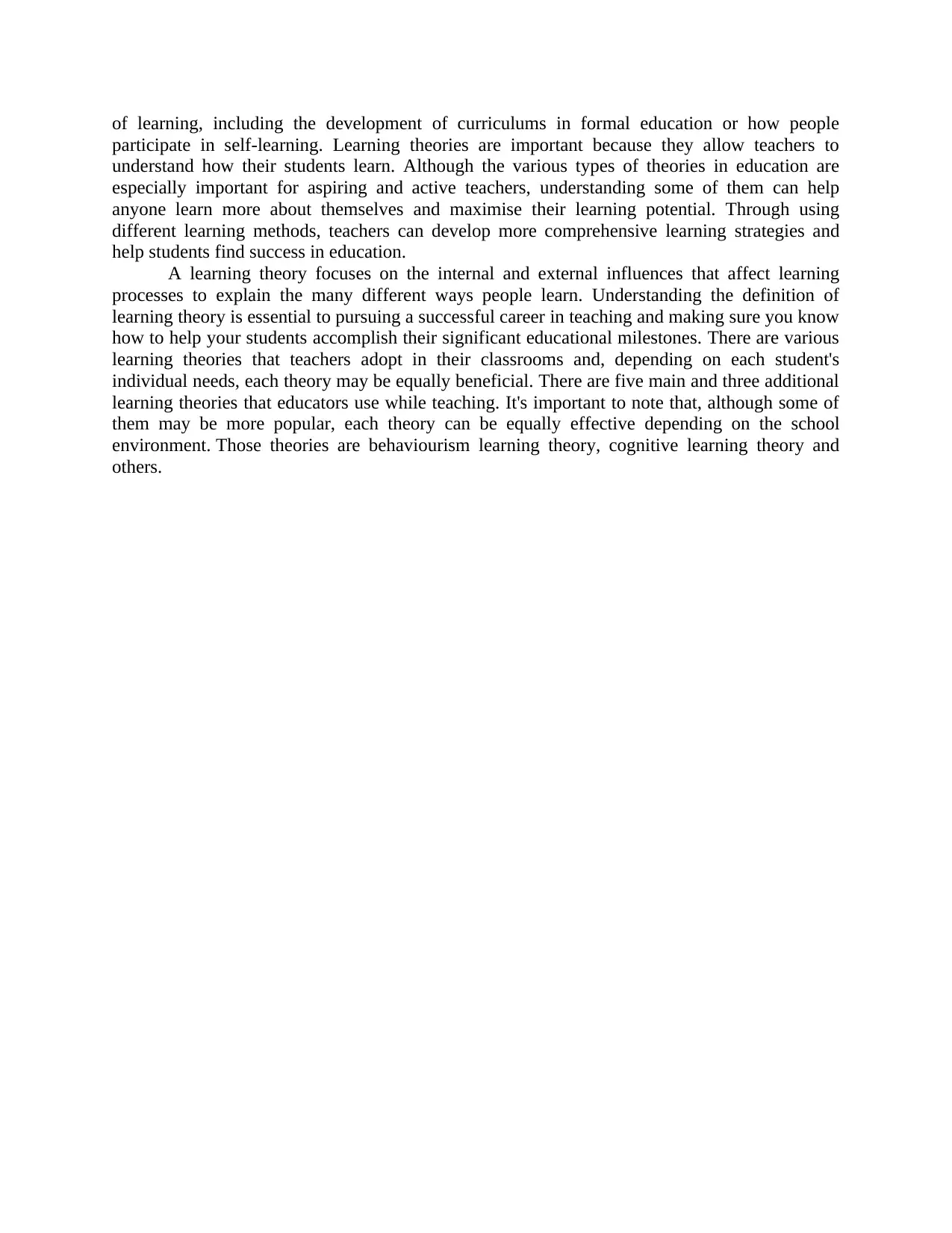
of learning, including the development of curriculums in formal education or how people
participate in self-learning. Learning theories are important because they allow teachers to
understand how their students learn. Although the various types of theories in education are
especially important for aspiring and active teachers, understanding some of them can help
anyone learn more about themselves and maximise their learning potential. Through using
different learning methods, teachers can develop more comprehensive learning strategies and
help students find success in education.
A learning theory focuses on the internal and external influences that affect learning
processes to explain the many different ways people learn. Understanding the definition of
learning theory is essential to pursuing a successful career in teaching and making sure you know
how to help your students accomplish their significant educational milestones. There are various
learning theories that teachers adopt in their classrooms and, depending on each student's
individual needs, each theory may be equally beneficial. There are five main and three additional
learning theories that educators use while teaching. It's important to note that, although some of
them may be more popular, each theory can be equally effective depending on the school
environment. Those theories are behaviourism learning theory, cognitive learning theory and
others.
participate in self-learning. Learning theories are important because they allow teachers to
understand how their students learn. Although the various types of theories in education are
especially important for aspiring and active teachers, understanding some of them can help
anyone learn more about themselves and maximise their learning potential. Through using
different learning methods, teachers can develop more comprehensive learning strategies and
help students find success in education.
A learning theory focuses on the internal and external influences that affect learning
processes to explain the many different ways people learn. Understanding the definition of
learning theory is essential to pursuing a successful career in teaching and making sure you know
how to help your students accomplish their significant educational milestones. There are various
learning theories that teachers adopt in their classrooms and, depending on each student's
individual needs, each theory may be equally beneficial. There are five main and three additional
learning theories that educators use while teaching. It's important to note that, although some of
them may be more popular, each theory can be equally effective depending on the school
environment. Those theories are behaviourism learning theory, cognitive learning theory and
others.
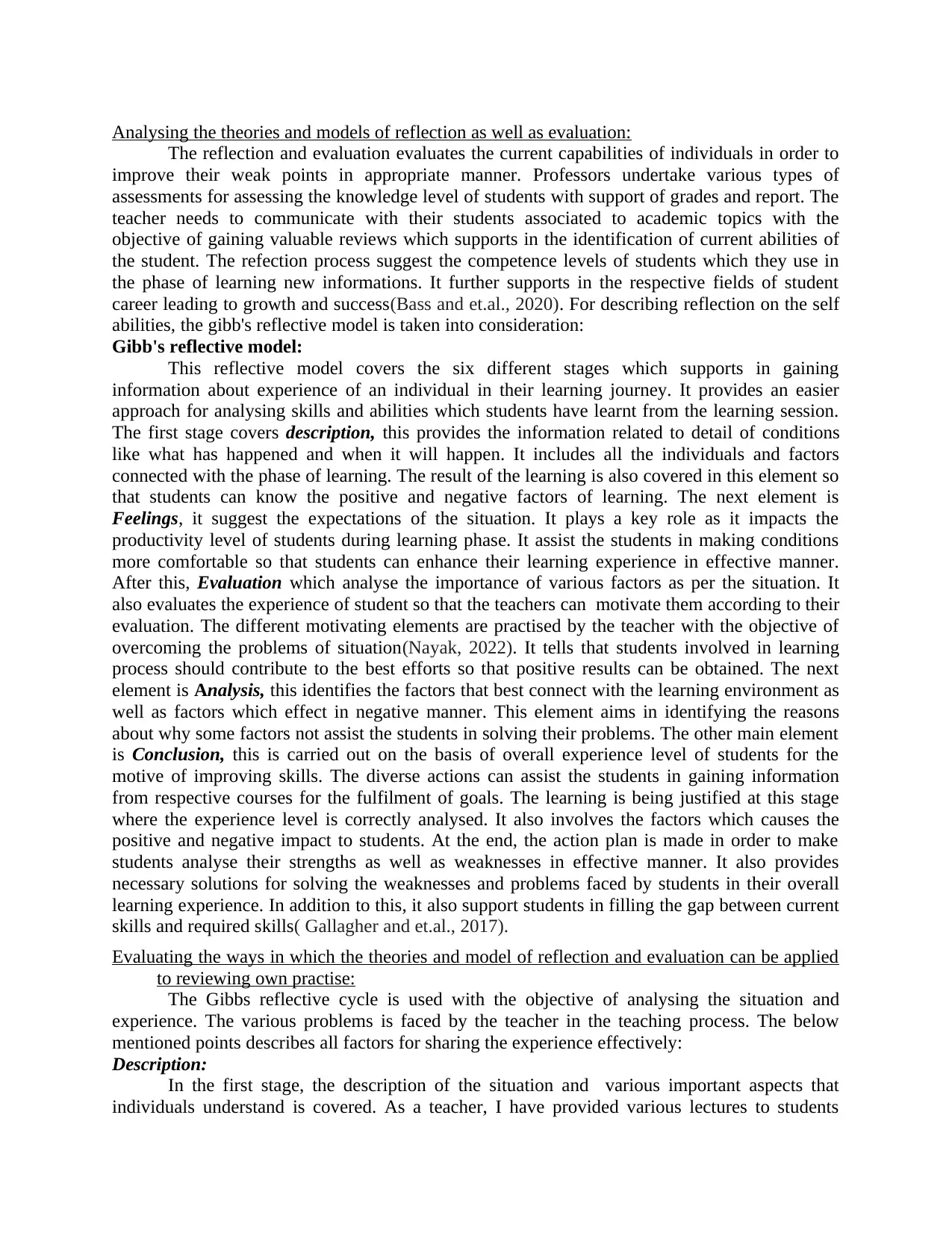
Analysing the theories and models of reflection as well as evaluation:
The reflection and evaluation evaluates the current capabilities of individuals in order to
improve their weak points in appropriate manner. Professors undertake various types of
assessments for assessing the knowledge level of students with support of grades and report. The
teacher needs to communicate with their students associated to academic topics with the
objective of gaining valuable reviews which supports in the identification of current abilities of
the student. The refection process suggest the competence levels of students which they use in
the phase of learning new informations. It further supports in the respective fields of student
career leading to growth and success(Bass and et.al., 2020). For describing reflection on the self
abilities, the gibb's reflective model is taken into consideration:
Gibb's reflective model:
This reflective model covers the six different stages which supports in gaining
information about experience of an individual in their learning journey. It provides an easier
approach for analysing skills and abilities which students have learnt from the learning session.
The first stage covers description, this provides the information related to detail of conditions
like what has happened and when it will happen. It includes all the individuals and factors
connected with the phase of learning. The result of the learning is also covered in this element so
that students can know the positive and negative factors of learning. The next element is
Feelings, it suggest the expectations of the situation. It plays a key role as it impacts the
productivity level of students during learning phase. It assist the students in making conditions
more comfortable so that students can enhance their learning experience in effective manner.
After this, Evaluation which analyse the importance of various factors as per the situation. It
also evaluates the experience of student so that the teachers can motivate them according to their
evaluation. The different motivating elements are practised by the teacher with the objective of
overcoming the problems of situation(Nayak, 2022). It tells that students involved in learning
process should contribute to the best efforts so that positive results can be obtained. The next
element is Analysis, this identifies the factors that best connect with the learning environment as
well as factors which effect in negative manner. This element aims in identifying the reasons
about why some factors not assist the students in solving their problems. The other main element
is Conclusion, this is carried out on the basis of overall experience level of students for the
motive of improving skills. The diverse actions can assist the students in gaining information
from respective courses for the fulfilment of goals. The learning is being justified at this stage
where the experience level is correctly analysed. It also involves the factors which causes the
positive and negative impact to students. At the end, the action plan is made in order to make
students analyse their strengths as well as weaknesses in effective manner. It also provides
necessary solutions for solving the weaknesses and problems faced by students in their overall
learning experience. In addition to this, it also support students in filling the gap between current
skills and required skills( Gallagher and et.al., 2017).
Evaluating the ways in which the theories and model of reflection and evaluation can be applied
to reviewing own practise:
The Gibbs reflective cycle is used with the objective of analysing the situation and
experience. The various problems is faced by the teacher in the teaching process. The below
mentioned points describes all factors for sharing the experience effectively:
Description:
In the first stage, the description of the situation and various important aspects that
individuals understand is covered. As a teacher, I have provided various lectures to students
The reflection and evaluation evaluates the current capabilities of individuals in order to
improve their weak points in appropriate manner. Professors undertake various types of
assessments for assessing the knowledge level of students with support of grades and report. The
teacher needs to communicate with their students associated to academic topics with the
objective of gaining valuable reviews which supports in the identification of current abilities of
the student. The refection process suggest the competence levels of students which they use in
the phase of learning new informations. It further supports in the respective fields of student
career leading to growth and success(Bass and et.al., 2020). For describing reflection on the self
abilities, the gibb's reflective model is taken into consideration:
Gibb's reflective model:
This reflective model covers the six different stages which supports in gaining
information about experience of an individual in their learning journey. It provides an easier
approach for analysing skills and abilities which students have learnt from the learning session.
The first stage covers description, this provides the information related to detail of conditions
like what has happened and when it will happen. It includes all the individuals and factors
connected with the phase of learning. The result of the learning is also covered in this element so
that students can know the positive and negative factors of learning. The next element is
Feelings, it suggest the expectations of the situation. It plays a key role as it impacts the
productivity level of students during learning phase. It assist the students in making conditions
more comfortable so that students can enhance their learning experience in effective manner.
After this, Evaluation which analyse the importance of various factors as per the situation. It
also evaluates the experience of student so that the teachers can motivate them according to their
evaluation. The different motivating elements are practised by the teacher with the objective of
overcoming the problems of situation(Nayak, 2022). It tells that students involved in learning
process should contribute to the best efforts so that positive results can be obtained. The next
element is Analysis, this identifies the factors that best connect with the learning environment as
well as factors which effect in negative manner. This element aims in identifying the reasons
about why some factors not assist the students in solving their problems. The other main element
is Conclusion, this is carried out on the basis of overall experience level of students for the
motive of improving skills. The diverse actions can assist the students in gaining information
from respective courses for the fulfilment of goals. The learning is being justified at this stage
where the experience level is correctly analysed. It also involves the factors which causes the
positive and negative impact to students. At the end, the action plan is made in order to make
students analyse their strengths as well as weaknesses in effective manner. It also provides
necessary solutions for solving the weaknesses and problems faced by students in their overall
learning experience. In addition to this, it also support students in filling the gap between current
skills and required skills( Gallagher and et.al., 2017).
Evaluating the ways in which the theories and model of reflection and evaluation can be applied
to reviewing own practise:
The Gibbs reflective cycle is used with the objective of analysing the situation and
experience. The various problems is faced by the teacher in the teaching process. The below
mentioned points describes all factors for sharing the experience effectively:
Description:
In the first stage, the description of the situation and various important aspects that
individuals understand is covered. As a teacher, I have provided various lectures to students
⊘ This is a preview!⊘
Do you want full access?
Subscribe today to unlock all pages.

Trusted by 1+ million students worldwide
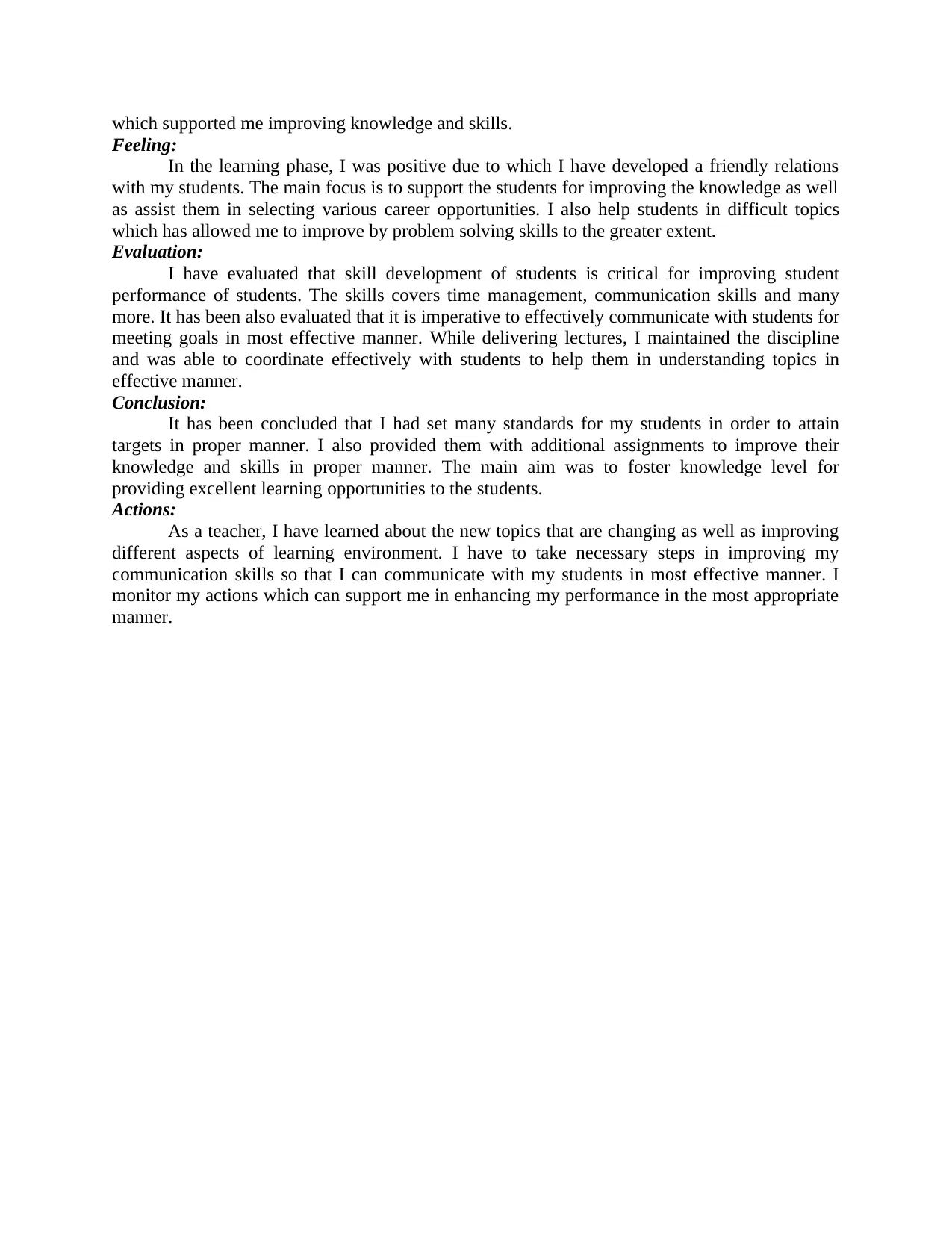
which supported me improving knowledge and skills.
Feeling:
In the learning phase, I was positive due to which I have developed a friendly relations
with my students. The main focus is to support the students for improving the knowledge as well
as assist them in selecting various career opportunities. I also help students in difficult topics
which has allowed me to improve by problem solving skills to the greater extent.
Evaluation:
I have evaluated that skill development of students is critical for improving student
performance of students. The skills covers time management, communication skills and many
more. It has been also evaluated that it is imperative to effectively communicate with students for
meeting goals in most effective manner. While delivering lectures, I maintained the discipline
and was able to coordinate effectively with students to help them in understanding topics in
effective manner.
Conclusion:
It has been concluded that I had set many standards for my students in order to attain
targets in proper manner. I also provided them with additional assignments to improve their
knowledge and skills in proper manner. The main aim was to foster knowledge level for
providing excellent learning opportunities to the students.
Actions:
As a teacher, I have learned about the new topics that are changing as well as improving
different aspects of learning environment. I have to take necessary steps in improving my
communication skills so that I can communicate with my students in most effective manner. I
monitor my actions which can support me in enhancing my performance in the most appropriate
manner.
Feeling:
In the learning phase, I was positive due to which I have developed a friendly relations
with my students. The main focus is to support the students for improving the knowledge as well
as assist them in selecting various career opportunities. I also help students in difficult topics
which has allowed me to improve by problem solving skills to the greater extent.
Evaluation:
I have evaluated that skill development of students is critical for improving student
performance of students. The skills covers time management, communication skills and many
more. It has been also evaluated that it is imperative to effectively communicate with students for
meeting goals in most effective manner. While delivering lectures, I maintained the discipline
and was able to coordinate effectively with students to help them in understanding topics in
effective manner.
Conclusion:
It has been concluded that I had set many standards for my students in order to attain
targets in proper manner. I also provided them with additional assignments to improve their
knowledge and skills in proper manner. The main aim was to foster knowledge level for
providing excellent learning opportunities to the students.
Actions:
As a teacher, I have learned about the new topics that are changing as well as improving
different aspects of learning environment. I have to take necessary steps in improving my
communication skills so that I can communicate with my students in most effective manner. I
monitor my actions which can support me in enhancing my performance in the most appropriate
manner.
Paraphrase This Document
Need a fresh take? Get an instant paraphrase of this document with our AI Paraphraser

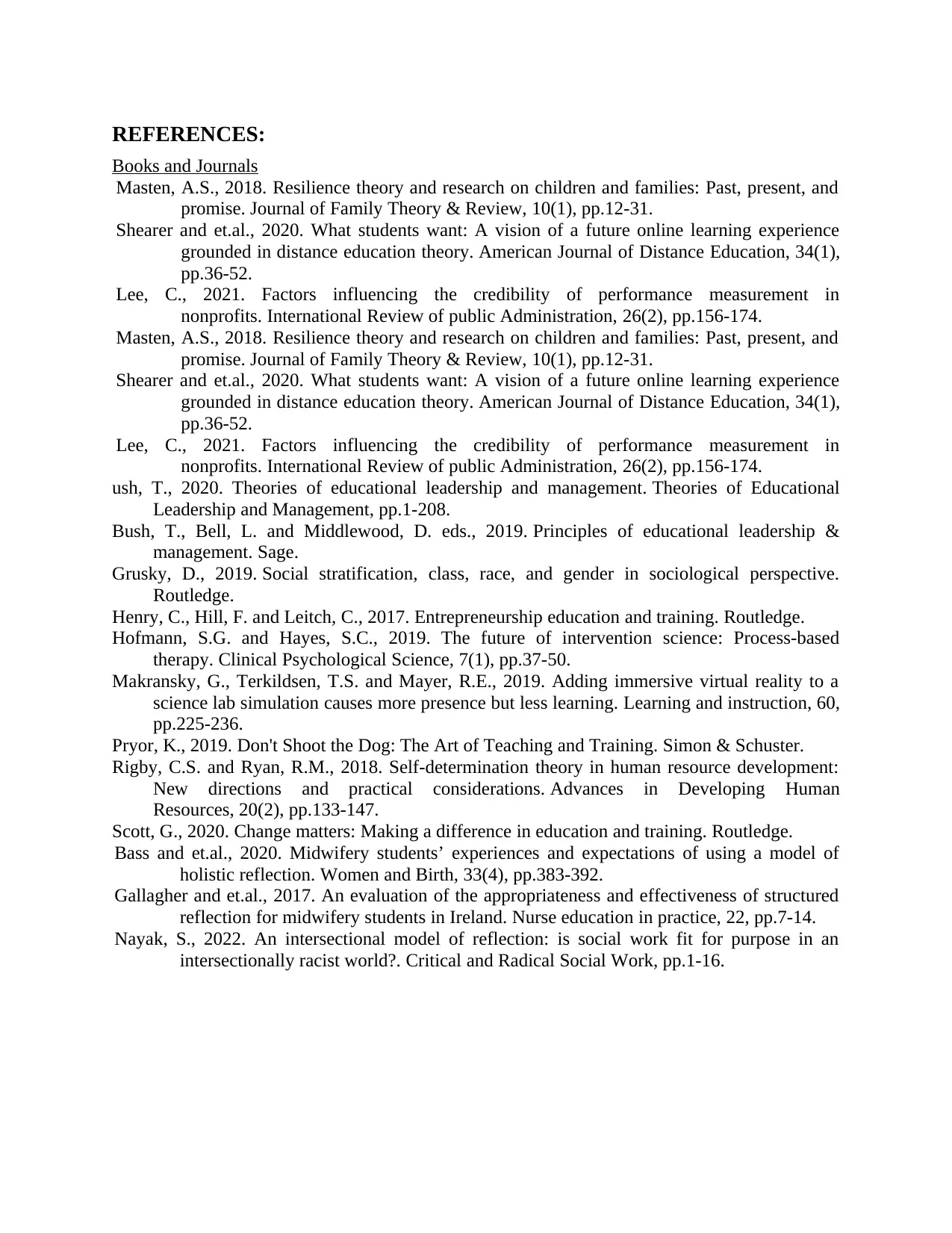
REFERENCES:
Books and Journals
Masten, A.S., 2018. Resilience theory and research on children and families: Past, present, and
promise. Journal of Family Theory & Review, 10(1), pp.12-31.
Shearer and et.al., 2020. What students want: A vision of a future online learning experience
grounded in distance education theory. American Journal of Distance Education, 34(1),
pp.36-52.
Lee, C., 2021. Factors influencing the credibility of performance measurement in
nonprofits. International Review of public Administration, 26(2), pp.156-174.
Masten, A.S., 2018. Resilience theory and research on children and families: Past, present, and
promise. Journal of Family Theory & Review, 10(1), pp.12-31.
Shearer and et.al., 2020. What students want: A vision of a future online learning experience
grounded in distance education theory. American Journal of Distance Education, 34(1),
pp.36-52.
Lee, C., 2021. Factors influencing the credibility of performance measurement in
nonprofits. International Review of public Administration, 26(2), pp.156-174.
ush, T., 2020. Theories of educational leadership and management. Theories of Educational
Leadership and Management, pp.1-208.
Bush, T., Bell, L. and Middlewood, D. eds., 2019. Principles of educational leadership &
management. Sage.
Grusky, D., 2019. Social stratification, class, race, and gender in sociological perspective.
Routledge.
Henry, C., Hill, F. and Leitch, C., 2017. Entrepreneurship education and training. Routledge.
Hofmann, S.G. and Hayes, S.C., 2019. The future of intervention science: Process-based
therapy. Clinical Psychological Science, 7(1), pp.37-50.
Makransky, G., Terkildsen, T.S. and Mayer, R.E., 2019. Adding immersive virtual reality to a
science lab simulation causes more presence but less learning. Learning and instruction, 60,
pp.225-236.
Pryor, K., 2019. Don't Shoot the Dog: The Art of Teaching and Training. Simon & Schuster.
Rigby, C.S. and Ryan, R.M., 2018. Self-determination theory in human resource development:
New directions and practical considerations. Advances in Developing Human
Resources, 20(2), pp.133-147.
Scott, G., 2020. Change matters: Making a difference in education and training. Routledge.
Bass and et.al., 2020. Midwifery students’ experiences and expectations of using a model of
holistic reflection. Women and Birth, 33(4), pp.383-392.
Gallagher and et.al., 2017. An evaluation of the appropriateness and effectiveness of structured
reflection for midwifery students in Ireland. Nurse education in practice, 22, pp.7-14.
Nayak, S., 2022. An intersectional model of reflection: is social work fit for purpose in an
intersectionally racist world?. Critical and Radical Social Work, pp.1-16.
Books and Journals
Masten, A.S., 2018. Resilience theory and research on children and families: Past, present, and
promise. Journal of Family Theory & Review, 10(1), pp.12-31.
Shearer and et.al., 2020. What students want: A vision of a future online learning experience
grounded in distance education theory. American Journal of Distance Education, 34(1),
pp.36-52.
Lee, C., 2021. Factors influencing the credibility of performance measurement in
nonprofits. International Review of public Administration, 26(2), pp.156-174.
Masten, A.S., 2018. Resilience theory and research on children and families: Past, present, and
promise. Journal of Family Theory & Review, 10(1), pp.12-31.
Shearer and et.al., 2020. What students want: A vision of a future online learning experience
grounded in distance education theory. American Journal of Distance Education, 34(1),
pp.36-52.
Lee, C., 2021. Factors influencing the credibility of performance measurement in
nonprofits. International Review of public Administration, 26(2), pp.156-174.
ush, T., 2020. Theories of educational leadership and management. Theories of Educational
Leadership and Management, pp.1-208.
Bush, T., Bell, L. and Middlewood, D. eds., 2019. Principles of educational leadership &
management. Sage.
Grusky, D., 2019. Social stratification, class, race, and gender in sociological perspective.
Routledge.
Henry, C., Hill, F. and Leitch, C., 2017. Entrepreneurship education and training. Routledge.
Hofmann, S.G. and Hayes, S.C., 2019. The future of intervention science: Process-based
therapy. Clinical Psychological Science, 7(1), pp.37-50.
Makransky, G., Terkildsen, T.S. and Mayer, R.E., 2019. Adding immersive virtual reality to a
science lab simulation causes more presence but less learning. Learning and instruction, 60,
pp.225-236.
Pryor, K., 2019. Don't Shoot the Dog: The Art of Teaching and Training. Simon & Schuster.
Rigby, C.S. and Ryan, R.M., 2018. Self-determination theory in human resource development:
New directions and practical considerations. Advances in Developing Human
Resources, 20(2), pp.133-147.
Scott, G., 2020. Change matters: Making a difference in education and training. Routledge.
Bass and et.al., 2020. Midwifery students’ experiences and expectations of using a model of
holistic reflection. Women and Birth, 33(4), pp.383-392.
Gallagher and et.al., 2017. An evaluation of the appropriateness and effectiveness of structured
reflection for midwifery students in Ireland. Nurse education in practice, 22, pp.7-14.
Nayak, S., 2022. An intersectional model of reflection: is social work fit for purpose in an
intersectionally racist world?. Critical and Radical Social Work, pp.1-16.
⊘ This is a preview!⊘
Do you want full access?
Subscribe today to unlock all pages.

Trusted by 1+ million students worldwide
1 out of 13
Related Documents
Your All-in-One AI-Powered Toolkit for Academic Success.
+13062052269
info@desklib.com
Available 24*7 on WhatsApp / Email
![[object Object]](/_next/static/media/star-bottom.7253800d.svg)
Unlock your academic potential
Copyright © 2020–2025 A2Z Services. All Rights Reserved. Developed and managed by ZUCOL.


